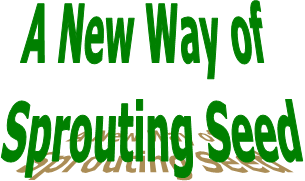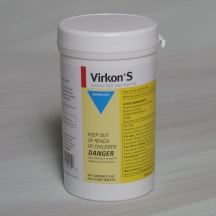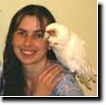
By Mike Fidler
One of the most exciting things to come out of the Save the Gouldian Research Program sponsored by the Save The Gouldian Fund is a new SAFER way of sprouting seed.
 The basic problem as Mike saw it was in the warm and often humid climate of
The basic problem as Mike saw it was in the warm and often humid climate of
They determined that the minimum volume of Virkon® S needed to soak their seed would be 5ml mixed into 1.25 liters of soaking water. However Mike cautions that using Virkon® S is a SAFER method, not a FOOLPROOF way to sprout seed.
Mike cautions that you should not take liberties or take silly risks when sprouting seed for your birds. There are a tremendous number of variables which they could not take into consideration in their trials to determine the optimum way for you to sprout your seed.
-
How dirty is YOUR seed
-
What is YOUR local climate
-
How clean are YOUR feed pots
To determine the optimum amount of Virkon® S that you should use under YOUR conditions, he suggests that you set up a little experiment. He recommends setting up a container system that he describes below and adding 5ml of Virkon® S to the soaking water. After soaking and draining the seed, leave it on the bench top for 4 days and then take it to your local vet for analysis. If it fails the test, double the amount of Virkon S and do exactly the same as for the first test. If that one fails the vet’s test, carry on increasing the amount of Virkon® S until you find the perfect soaking solution mix for your own conditions.
Mike’s Sprouting Method
What you will need:
· 2 plastic containers that fit inside of each other. You will need a lid for one of the containers. The container needs to be large enough to hold 1Kg (1 liter) of sprouting seed.
· Make lots of holes in the bottom and part way up the sides of one of the plastic containers – 1/16th inch or in metric 1.59mm.
· Put in 1Kg of sprouting seed into the container with holes (a liter measure full)
· Put this container with seed inside of the container without holes
· Add a minimum of 1 teaspoon (5ml) of powdered Virkon® S or 1 tablet
· Add approximately 1.25 liters of water and stir to disperse the Virkon® S. If you are using the tablet form of Virkon S, I would dissolve the tablet in the water before adding the water to the container.
· Leave to soak for a minimum if 3 hours to a maximum of 4 hours. Soaking for longer makes it soggy, slower to dry and increases the risk of pathogens.
· Separate the containers and leave the seed to drain, put the lid loosely on the top for about 12 hours to retain humidity & then remove so seed will start drying.
Within 14-30 hours, dependant on the seed-mix type & ambient temperatures, the mix will have “chitted”. This is the correct stage to feed it at. A longer sprout means it has lost a lot of its nutrient value.
DO NOT RINSE AT ANY TIME – THERE IS NO NEED – YOU CAN FEED IT STRAIGHT TO THE BIRDS
OR FREEZE IT TO BE USED LATER.
SEED SPROUTED THIS WAY CAN BE KEPT IN THE FREEZER FOR UP TO ONE YEAR.
The only thing you need to remember if you are going to freeze your sprouted seed, is that the seed needs to be reasonably dry when you put it in the freezer. Otherwise it will come out as a solid block of ice!
About half way through the sprouting process, Mike uses a fork and rakes the seed on the bottom of the container to the top and then leaves the lid off, so that it will dry out a bit. It needs to be just moist, not wet. When it comes out of the freezer, if you have got the moisture content right, it will be nice and friable and easily crumble. Frozen seed may be fed directly to the birds or mixed in with your soft food…it does not need to be defrosted first.
At the Save the Gouldian Fund, they make up a large batch of sprouted seed to last approximately two months, and put it in the freezer…not the fridge!
Enough of the frozen seed to last one week is taken out and mixed into a batch of soft food and then stored in the freezer again, ready for daily use. Each morning, the ready mixed soft food is taken out of the freezer and fed directly to each cage without thawing first. Each cage is fed only enough to last them one day. The following morning, anything that is left in the feed pots is thrown away and the pots changed for clean ones which have been through the dishwasher and therefore are pathogen free.
The only risk they take (and are getting away with) is that any surplus they have left after the morning rounds goes back in the freezer, even though it is partially thawed. Mike strongly cautions that this may not be safe if you use a different brand of soft food to the one that they use at the Save the Gouldian Fund.
Why Sprout Seed Anyway?
The reason is that the sprouting process enhances the nutritional value of seed by up to 300%!! Furthermore, the process increases the amount of fructose and glucose creating a high energy package, thus making it easier for small nestlings to digest.
At the Save the Gouldian Fund, they use two different seed mixes to sprout…one Black Mix and one White Mix. The reason that they do this is because the seeds in each mix germinate at different speeds.
For use as a Disinfectant & Virucide
VIRKON® S - Disinfectant and Virucide Tablets for use in cleaning and disinfecting industrial, animal and agricultural facilities. A 1% solution of Virkon® S Disinfectant and Virucide is recommended as a "one step" cleaning and disinfecting procedure (remove gross filth and heavy soil deposits before application of the disinfecting/cleaning solution) for all surfaces, equipment, instruments, utensils and cages, caging systems, within or associated with Veterinary Medical Hospitals, infectious disease wards, quarantine areas, Humane Society facilities, laboratory animal quarters, grooming and boarding facilities, kennels, catteries and animal transportation vehicles. Effective against Viruses, Bacteria, and Fungi (molds and yeasts - Not Approved for this use in
Each "Easy to Use Tablet" makes a 1% Use Solution when mixed with 1 Pint (16 fl oz) of water. Solutions are stable for 7 days.
Do not soak metal objects in Virkon® S for long periods. 10 minutes is maximum necessary contact time.
KEEP OUT OF REACH OF CHILDREN
CORROSIVE STATEMENT:
Powder/Tablet is a Dangerous Corrosive. Do not get in eyes, on skin or on clothing. Causes irreversible eye damage or skin burns. Read all labeling Precautionary Statements and follow Instructions for Use and Disposal.
Corrosive statement refers to powder/tablet only, and not in use solution.
Active Ingredients:
Potassium peroxymonosulfate 21.41%
Sodium Chloride 1.5%
Equivalent to 9.75% Available Chlorine
Packaging: 50 Tablets @ 0.18 oz (5.1 grams) each or 10# Tub
I no longer sell Virkon S, but it can be purchased on-line from several retailers. Just do a Google search for it.





